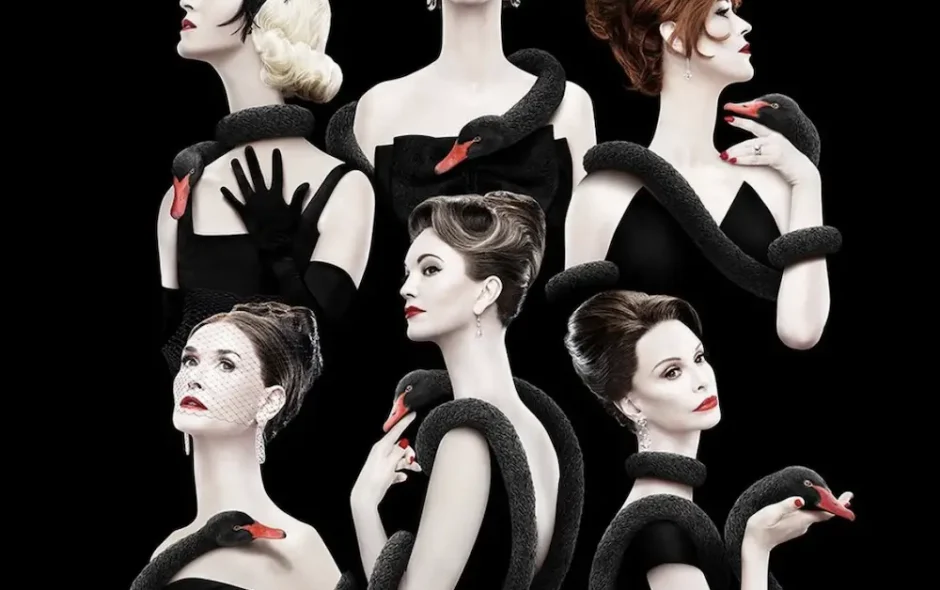Capote vs. the Swans is a stylish, dramatic miniseries. It tells the story of Truman Capote at the height of his fame and the beginning of his fall. Capote was already celebrated as a literary genius after the success of In Cold Blood, and he cemented his place as a cultural icon with his flamboyant charm, sharp wit, and talent for making himself the center of attention. In New York’s social world, he became inseparable from a circle of women known as the Swans. These were women of wealth, style, and influence, including Babe Paley, Slim Keith, C.Z. Guest, and Lee Radziwill. They allowed Capote into their private world, confiding in him, trusting him, and treating him as both confidant and court jester. In return, he gave them laughter, companionship, and the reflected glow of his fame. For a time, it was a symbiotic relationship, but beneath the glittering surface lay fault lines of ego, envy, and the writer’s hunger for material.
Capote’s downfall began with his decision to draw on the secrets his friends had shared for his long-anticipated novel Answered Prayers. Excerpts that surfaced in the 1970s revealed barely disguised portraits of the Swans, their affairs, betrayals, and scandals laid bare for readers. What Capote considered his greatest work in progress, modeled after Proust’s Remembrance of Things Past, became instead a weapon against the very people who had given him entrée into their exclusive circles. The women felt betrayed, humiliated, and exposed. Overnight, doors that had once opened to him were slammed shut. Parties no longer extended invitations, and gossip that once amused became cutting and cruel.
The series paints a portrait not just of Capote’s unraveling friendships but of his own descent into isolation. The Swans’ rejection devastated him. The lavish parties, the weekends in palatial homes, the glamorous dinners at Manhattan’s finest restaurants were gone, leaving him to grapple with loneliness and an increasing dependence on drugs and alcohol. His wit and brilliance remained, but the sparkle dulled as he found himself cast out of the world he had once ruled with a mix of charm and cruelty. What makes the series compelling is the way it explores the double-edged sword of Capote’s genius. His need to turn life into art produced groundbreaking literature, but it also destroyed his closest relationships. The Swans, elegant and fragile in their own ways, became symbols of a culture that prized appearances above all else, and Capote, once their darling, became the cautionary tale of ambition unchecked by loyalty.
Where Capote vs. the Swans unfolds in salons and luxury apartments, Fight Night: The Million Dollar Heist bursts into life with a crime that exposed both the glamour and the grit of 1970 Atlanta. The city was hosting Muhammad Ali’s comeback fight against Jerry Quarry in 1970, an event that drew celebrities, politicians, hustlers, and business elites. For Atlanta, a city balancing its reputation as “the city too busy to hate” with the realities of racial and economic inequality, the fight was supposed to be a crowning moment of modernity and progress. The atmosphere was electric, a blend of Southern hospitality and the global spotlight of boxing’s biggest name returning to the ring.
Beneath the celebration, however, was a plan for one of the boldest heists in American history. On the night of the fight, thieves targeted wealthy partygoers and businesses tied to the event, making off with millions in cash and valuables. The series follows the intricate planning of the robbery, the tense execution, and the explosive aftermath. Law enforcement scrambled to contain the chaos, suspects emerged from Atlanta’s underworld, and the city’s image was suddenly at stake. What might have been remembered as a triumphant night in sports history became overshadowed by scandal and fear.
The miniseries does more than tell the story of the crime. It captures the tensions of the South at that time, when progress and tradition clashed daily. Characters include hustlers who saw the fight as an opportunity to strike, detectives trying to hold a fragile peace, and politicians eager to protect Atlanta’s carefully crafted reputation as a forward-looking city. At its core, the story raises questions about justice, inequality, and the thin line between opportunity and exploitation. The heist becomes a metaphor for a city in transition, a place where old hierarchies still lingered but new forces were reshaping the landscape.
Fight Night: The Million Dollar Heist brims with suspense and period detail, but what gives it weight is the way it examines the broader forces at play. Atlanta was a city where Black political and business leadership was beginning to emerge, but it was also a place where organized crime and systemic inequities remained deeply entrenched. By weaving together these strands, the series does more than dramatize a crime; it reflects the contradictions of a moment in history when the South was redefining itself in front of the world.
Taken together, the two miniseries present contrasting but equally compelling portraits of American ambition and downfall. Capote vs. the Swans shows the costs of betrayal in a world built on appearances, while Fight Night: The Million Dollar Heist highlights the volatility of a city on the cusp of change. Both remind us that behind every glamorous façade lies fragility, and beneath every celebration lurks the possibility of chaos.




